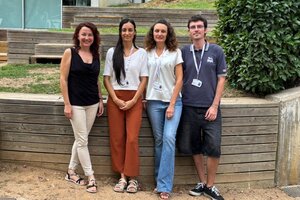The use of artificial intelligence improves the diagnosis of a rare neuromuscular disease
The Confocal Microscopy and Cellular Imaging Unit at SJD Barcelona Children’s Hospital and the Applied Research Group in Neuromuscular Diseases at the Institut de Recerca Sant Joan de Déu (IRSJD), in collaboration with the Institut de Robòtica i Informàtica Industrial (CSIC-UPC), have demonstrated how artificial intelligence (AI) can contribute to more efficiently diagnosing collagen VI-related congenital muscular dystrophy (COL6-CMD), a rare early-onset disease.
Congenital muscular dystrophy
Congenital muscular dystrophy (CMD) is a group of rare genetic diseases that affect skeletal muscle and manifest from birth or during the first months of life.
It is caused by genetic mutations that alter essential proteins for muscle function and integrity. There are various forms depending on the affected gene. One of the best-known is collagen VI-related congenital muscular dystrophy (COL6-CMD).
In the study The artificial intelligence challenge in rare disease diagnosis: A case study on collagen VI muscular dystrophy, published in the journal Computers in Biology and Medicine, the team applied machine learning and deep learning techniques to analyze confocal microscopy images of skin fibroblasts, demonstrating that it is possible to obtain highly accurate classifiers despite having a limited number of samples.
Collagen VI (COL6-CMD)
Collagen VI is an essential structural protein of the extracellular matrix, particularly important in muscle and connective tissues. This protein acts as support and connection between cells and is key to maintaining the normal structure and function of muscle.
Collagen VI is encoded by three genes: COL6A1, COL6A2, and COL6A3. When mutations occur in these genes, alterations in the formation and organization of the collagen VI network arise, which can lead to various forms of muscular dystrophy.
"Our methodology transforms cellular images into key information to identify affected patients, even in mild cases that could be mistaken for controls. This tool complements the daily work of healthcare professionals and is always developed under the expertise of researchers in neuromuscular pathology, such as the Pediatric Neuromuscular Disease Applied Research Group at IRSJD, to ensure proper use," says Mònica Roldán, head of the Confocal Microscopy and Cellular Imaging Unit at HSJD.
The deep learning-based model, which combines transfer learning and data augmentation strategies, has achieved exceptional accuracy (AUC up to 0.96). Moreover, the integration of these tools into the clinical workflow at SJD Barcelona Children's Hospital has begun to provide objective support for evaluating the state of the collagen VI network in patient samples.
This study represents progress in the application of AI in the field of rare diseases, where data is typically scarce. The results open the door to adapting this methodology to other diseases also diagnosed through histological images.
BE-LIGHT
This research is part of the European BE-LIGHT project (HORIZON-MSCA-2022-DN), focused on improving biomedical diagnosis through optical technologies and machine learning, and is also supported by a grant from the Ramón Areces Foundation.

Our methodology transforms cellular images into key information to identify affected patients, even in mild cases that could be mistaken for controls.
